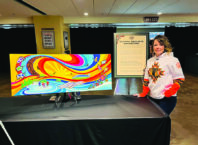
By Dan Ninham
Community leaders, project partners, and elected officials came together to celebrate the groundbreaking for a mixed-use development on the American Indian Cultural Corridor that will create a new 30,000-square-foot health center and 83 units of affordable housing, according to a press release by the Native American Community Clinic (NACC) and Wellington Management. Developed by the NACC and Wellington Management, the project is a model for integrated housing and culturally grounded care, where Indigenous elders, families, and youth can live and thrive.
The development marks a major step forward in NACC’s mission to promote the health and wellness of mind, body, and spirit for Native American families through a full range of medical, behavioral health, dental, and substance use treatment services. With a holistic approach that includes traditional healing and community-based outreach, the project will bring housing and health together in one space, responding with a model built on tradition, trust, and self-determination.

“This is not just a building. We are creating a home for Indigenous healing,” said Dr. Antony Stately, (Oneida/ Ojibwe) President and Executive Officer of NACC. “Our vision of health care is not just about treating illness – it’s about restoring balance. And balance is rooted in connection: to land, to water, to food, to ceremony, and to each other. That’s why this space brings housing and health together under one roof. It is unapologetically Indigenous, and we believe the future of health for everyone depends on prioritizing connection and balance.”
“This project reflects the power of collaboration,” said David Wellington, president of Wellington Management. “It’s not just about construction — it’s about honoring the community’s vision, creating space for healing, and building for future generations. We join with NACC to acknowledge the larger community of supporters whose commitment and funding is helping bring this transformational development to the American Indian Cultural Corridor.”
The new two-story clinic will consolidate NACC’s operations from four separate sites into one modern, culturally grounded facility. It will integrate medical, behavioral health, dental, and administrative services under one roof and expand NACC’s capacity to serve an additional 3,000 patients annually, bringing total visits to over 20,000 per year.
The housing component will include a mix of one- to four-bedroom units, with a focus on family housing. Most units will be affordable to households earning at or below 50% of the area median income (AMI), with 33 units reserved for those at or below 30% AMI. Of those, 20 units will be designated for individuals with disabilities or those who have experienced homelessness. Additional features include a community plaza for ceremony and cultural use, spaces for medicinal plantings, a rooftop garden, a children’s play area, and outdoor gathering spaces for residents and staff.
There are definite positives for the project but also challenges are evident in a huge investment in the community by a number of leaders and project partners.
Brett Edelson leads UnitedHealthcare of Minnesota. In an interview with The Circle, he said, “I was honored to be a speaker at the groundbreaking event. UnitedHealthcare of Minnesota is the part of UnitedHealth Group that serves our ‘home state’. The company is the largest private sector investor in the $55 million project, providing $17.9 million, through a partnership with Minnesota Equity Fund and Cinnaire. The company also invested $9.2 million in the Minnesota Indian Women’s Resource Center which started construction just a few blocks away last fall.”
Edelson also shared the positives to the building project and programs and what needs to be done to sustain it.
“NACC is a trusted source of healing and hope not just for care, but for connection, for cultural understanding, and for services that reflect values and traditions,” said Brett Edelson. “This project brings so many partners from within the community together and provides the opportunity for NACC to expand its reach and impact, particularly in connecting housing and health together to better serve Indigenous individuals and families.”
Edelson also addressed the challenges to the building project and programs and what needs to be done to make it better.
“Securing funding can be a challenge, which is why public-private partnerships like this – resulting in investments of $55 million – are so critical. NACC now has the ability to expand the important work and services they provide in the community,” said Edelson. “Importantly, this project also addresses the challenges of improving access to care and reducing health disparities.”
“Studies show that when families have a safe place to live, and access to the care they need, their health outcomes can improve. NACC’s new clinic and housing community will help deliver on that promise,” added Edelson.
Stephanie Graves, member of the Red Lake Band of Ojibwe, is Maternal Child and Adolescent Health Manager, Minneapolis Health Department. Graves is on the NACC board of directors and currently the board chairperson and community member.
Graves shared with The Circle the positives to building project and programs. She said, “The project provides a unique opportunity for NACC to provide our Native community health care from an Indigenous, cooperative, and relational approach to health and wellbeing, that supports Indigenous people, that will encourage physical, mental, and spiritual balance.”
“At the state level, continue policy and legislation forward to include Indigenous traditional medicine people seen as health/wellness providers,” Graves continued. “To be sustainable there needs to a change in allowable payor/billing expenses that include Indigenous wellness practices, as well as traditional medicines. Utilize community members in an advisory capacity to ensure the community is satisfied with programs. Stay informed on issues impacting land, water, environment that may impact Indigenous well-being.”
Graves also addressed the challenges. She said, “It will be challenging to continue health/wellness services at same capacity while under construction. Another challenge, the continued rising costs of building materials. The uncertainty due to the current political climate has caused for community clinics, health care providers, and behavioral health brings a new challenge we have not experienced ever before. Possible changes or decreases in federal funding, definitely pose a challenge.”
“NACC developed strategic plans to continue providing quality health/wellbeing services while under construction. Staying informed regarding issues that may impact Indigenous health care from the national, state, and local levels. Developing contingency plans if funding is impacted by national level decisions,” added Graves.






